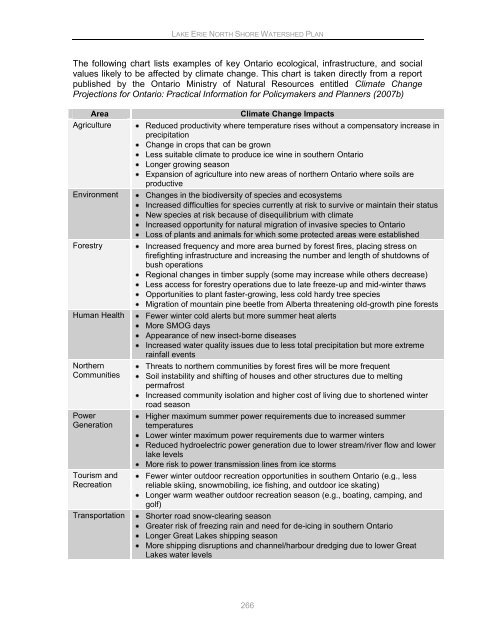Lake Erie North Shore Watershed Plan - Niagara Peninsula ...
Lake Erie North Shore Watershed Plan - Niagara Peninsula ...
Lake Erie North Shore Watershed Plan - Niagara Peninsula ...
You also want an ePaper? Increase the reach of your titles
YUMPU automatically turns print PDFs into web optimized ePapers that Google loves.
LAKE ERIE NORTH SHORE WATERSHED PLAN<br />
The following chart lists examples of key Ontario ecological, infrastructure, and social<br />
values likely to be affected by climate change. This chart is taken directly from a report<br />
published by the Ontario Ministry of Natural Resources entitled Climate Change<br />
Projections for Ontario: Practical Information for Policymakers and <strong>Plan</strong>ners (2007b)<br />
Area<br />
Agriculture<br />
Environment<br />
Forestry<br />
Human Health<br />
<strong>North</strong>ern<br />
Communities<br />
Power<br />
Generation<br />
Tourism and<br />
Recreation<br />
Transportation<br />
Climate Change Impacts<br />
Reduced productivity where temperature rises without a compensatory increase in<br />
precipitation<br />
Change in crops that can be grown<br />
Less suitable climate to produce ice wine in southern Ontario<br />
Longer growing season<br />
Expansion of agriculture into new areas of northern Ontario where soils are<br />
productive<br />
Changes in the biodiversity of species and ecosystems<br />
Increased difficulties for species currently at risk to survive or maintain their status<br />
New species at risk because of disequilibrium with climate<br />
Increased opportunity for natural migration of invasive species to Ontario<br />
Loss of plants and animals for which some protected areas were established<br />
Increased frequency and more area burned by forest fires, placing stress on<br />
firefighting infrastructure and increasing the number and length of shutdowns of<br />
bush operations<br />
Regional changes in timber supply (some may increase while others decrease)<br />
Less access for forestry operations due to late freeze-up and mid-winter thaws<br />
Opportunities to plant faster-growing, less cold hardy tree species<br />
Migration of mountain pine beetle from Alberta threatening old-growth pine forests<br />
Fewer winter cold alerts but more summer heat alerts<br />
More SMOG days<br />
Appearance of new insect-borne diseases<br />
Increased water quality issues due to less total precipitation but more extreme<br />
rainfall events<br />
Threats to northern communities by forest fires will be more frequent<br />
Soil instability and shifting of houses and other structures due to melting<br />
permafrost<br />
Increased community isolation and higher cost of living due to shortened winter<br />
road season<br />
Higher maximum summer power requirements due to increased summer<br />
temperatures<br />
Lower winter maximum power requirements due to warmer winters<br />
Reduced hydroelectric power generation due to lower stream/river flow and lower<br />
lake levels<br />
More risk to power transmission lines from ice storms<br />
Fewer winter outdoor recreation opportunities in southern Ontario (e.g., less<br />
reliable skiing, snowmobiling, ice fishing, and outdoor ice skating)<br />
Longer warm weather outdoor recreation season (e.g., boating, camping, and<br />
golf)<br />
Shorter road snow-clearing season<br />
Greater risk of freezing rain and need for de-icing in southern Ontario<br />
Longer Great <strong>Lake</strong>s shipping season<br />
More shipping disruptions and channel/harbour dredging due to lower Great<br />
<strong>Lake</strong>s water levels<br />
266
















